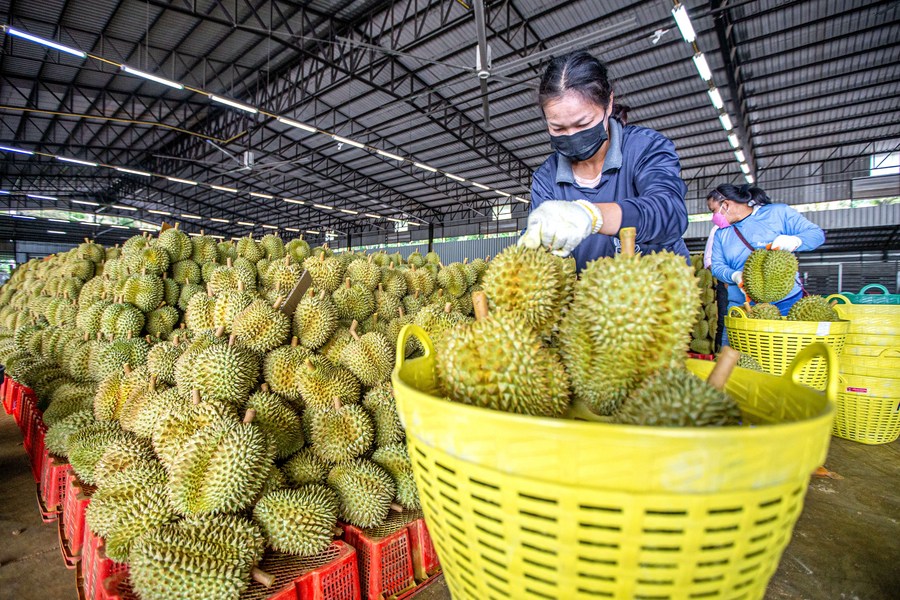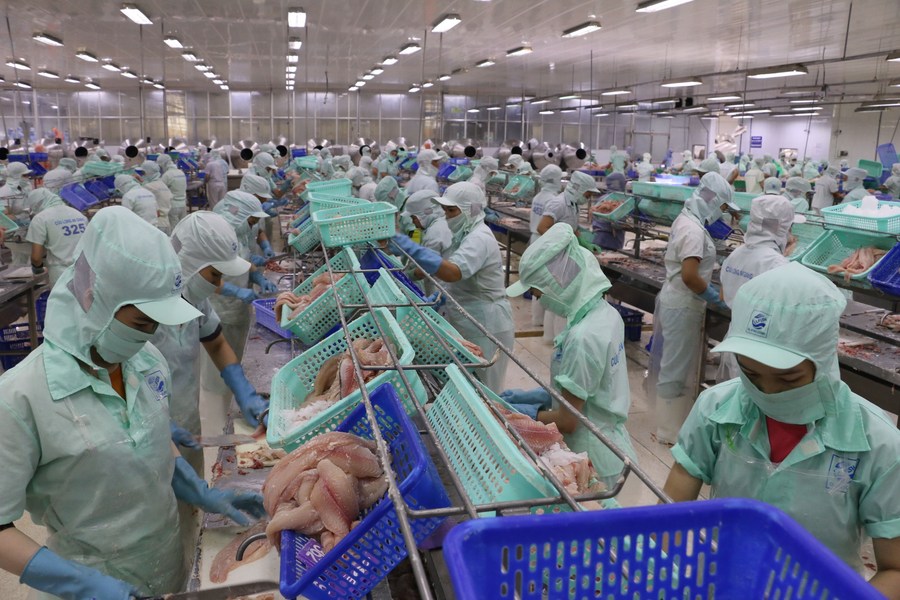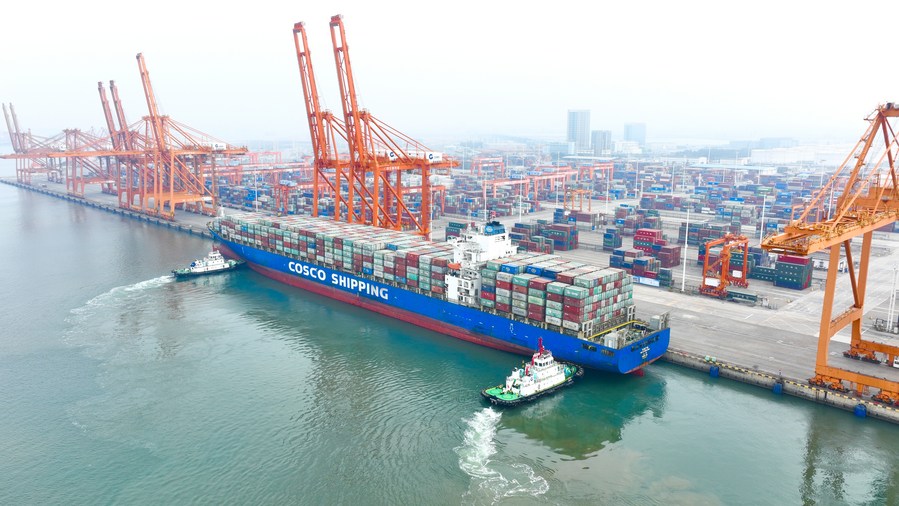Lower tariffs, faster customs clearance -- China, ASEAN share bounty of RCEP trade facilitation package
* The booming economic and trade cooperation between China and ASEAN countries has further gained steam as the RCEP agreement provided faster customs clearance and other trade facilitation measures.
* The RCEP will eventually eliminate tariffs on as much as 90 percent of goods traded within the region.
* Besides boosting trade growth, a more integrated regional supply chain under the RCEP agreement has also benefited China and ASEAN countries.
* The RCEP seeks to promote e-commerce and a digital economy which would be increasingly relevant in the post-pandemic world.
BANGKOK -- During Thailand's durian season every year, orders from China for the thorny "king of fruits" always surge, driving up shipments from the world's top fresh durian exporter.
This year, after the Regional Comprehensive Economic Partnership (RCEP), the world's largest free trade deal that entered into force in January, Thailand's durian sales to China have been further boosted.
"Up to 100 percent of our durians are shipped to China, and the demand is increasing year by year," said Silaphon Thongrot, who has managed a durian orchard for 15 years in east Thailand's Chanthaburi Province growing durian, mangosteen, rambutan and other fruits.
Faster customs clearance and other trade facilitation measures provided by the RCEP agreement, as well as the launch of the "Durian Express" and special fruit train services to China, helped boost the trade of Thai durians and reduce exporters' costs, said Narongsak Putthapornmongkol, president of the Thai-Chinese Chamber of Commerce.
Nuttakij Oranhirunruk, vice president of the Thai-Chinese Agribusiness Association, said he has full confidence in the substantial growth of Thailand's durian exports to China this year, expecting the eastern agricultural zone to export 35,000 containers this year, compared to 25,000 last year.

A worker arranges durians at a durian processing factory in the Chanthaburi province, Thailand, May 5, 2022. [Xinhua/Wang Teng]
The hot sale of Thai durians is just an example of the booming economic and trade cooperation between China and countries of the Association of Southeast Asian Nations (ASEAN), which has further gained steam after the RCEP agreement took effect.
Chinese customs data showed that in the first quarter of this year, trade between China and ASEAN accounted for 47.2 percent -- or nearly half -- of China's foreign trade with RCEP partners. With the RCEP agreement, ASEAN has once again overtaken the EU to become China's largest trading partner.
The momentum continued despite disruptions from COVID-19, with bilateral trade volume expanding 10.2 percent year-on-year during the January-May period.
Cambodian Commerce Minister Pan Sorasak considered the RCEP as a key driver for economic recovery in the participating countries both during and after the pandemic.
The minister said that under the RCEP, Cambodia is expected to see an annual export growth between 9.4 percent and 18 percent, which will contribute to national economic growth between 2 percent and 3.8 percent. Cambodia is the ASEAN chair this year.
The RCEP will eventually eliminate tariffs on as much as 90 percent of goods traded within the region. A study by the World Bank said the East Asia and Pacific region can reap significant benefits through further liberalization, with Cambodia, Vietnam and other lower-middle-income countries gaining the most from the RCEP.
"The region will also see an additional 'kick' in productivity as greater openness brings additional skills, technology and capital," the bank's research report said.

Workers process fish for export at a factory in An Giang province, Vietnam, March 14, 2022. [VNA/Handout via Xinhua]
Besides boosting trade growth, a more integrated regional supply chain under the RCEP agreement has also benefited China and ASEAN countries.
Businesses with global supply chains might face tariffs even within a free trade area if their products contain components that are made elsewhere. Under the RCEP's common rules of origin, parts from any member country would be treated equally, which might give companies in RCEP countries an incentive to look within the region for suppliers.
Himile (Thailand) Co., a tire mold supplier in eastern Thailand's Rayong Province, has already experienced the benefits.
The RCEP's tariff concessions, common rules of origin and simplification of customs procedures "enable us to purchase raw materials and equipment as well as distribution of products more efficiently and at a lower cost," said Qiu Jinliang, managing director of Himile (Thailand).
The company, which sources raw materials from China, Japan and South Korea while exporting products to the U.S., European and ASEAN markets, has seen the customs clearance time shortened by three days to a week per shipment while the costs of raw material imports have also been reduced, Qiu said.
Ong Tee Keat, founding chairman of the Center for New Inclusive Asia, a Malaysia-based think tank, said ASEAN countries can benefit greatly from the harmonized rules of origin under the RCEP as intermediate goods can be sourced across any of the 15 RCEP countries. Only a certain proportion of regional value content is required for goods to meet the RCEP rules of origin requirements for tariff concessions.
This could help lower the production costs of companies operating in the region, enhance the resilience of regional supply chains, and generate more investment, job opportunities and economic growth, he said.
The RCEP seeks to promote e-commerce and a digital economy which would be increasingly relevant in the post-pandemic world. "It will have implications not only on trade and economic growth, but also on promoting digital inclusiveness and a more level playing field," said Wichai Kinchong Choi, senior vice president of Kasikornbank, a leading Thai bank.
The RCEP is crucial for regional small and medium-sized enterprises, which took a big hit from COVID-19, as their capacity and competitiveness could be enhanced, enabling them to emerge stronger from an improved access to a larger RCEP market, he said.
Since the RCEP came into force, the development of cross-border e-commerce between China and ASEAN countries has been further enhanced.

Aerial photo taken on March 2, 2022 shows a view of the container terminal of Qinzhou Port in south China's Guangxi Zhuang Autonomous Region. [Xinhua]
As an important hub for China's cross-border e-commerce import and export business to ASEAN, south China's Guangxi Zhuang Autonomous Region has attracted more than 100 cross-border e-commerce enterprises, including the first cross-border innovation center of Southeast Asia's flagship e-commerce platform Lazada and the ASEAN cross-border e-commerce logistics center of Shopee.
"It (RCEP) is not just a simple trade agreement that provides enhanced market access and stable business environment. It is a strategic tool to sustain the region's economic advantage," said former Philippine Trade Secretary Ramon Lopez, calling for the country's early ratification of the mega trade deal, which he believed is "for the future of the economy."
The RCEP groups 10 ASEAN countries as well as China, Japan, South Korea, Australia and New Zealand. Only three participating countries, the Philippines, Indonesia and Myanmar, have not yet ratified the RCEP.
Video reporter: Guo Xinhui; video editors: Zhang Yuhong, Zhao Yuchao, Cao Ying, Liu Xiaoyue
























